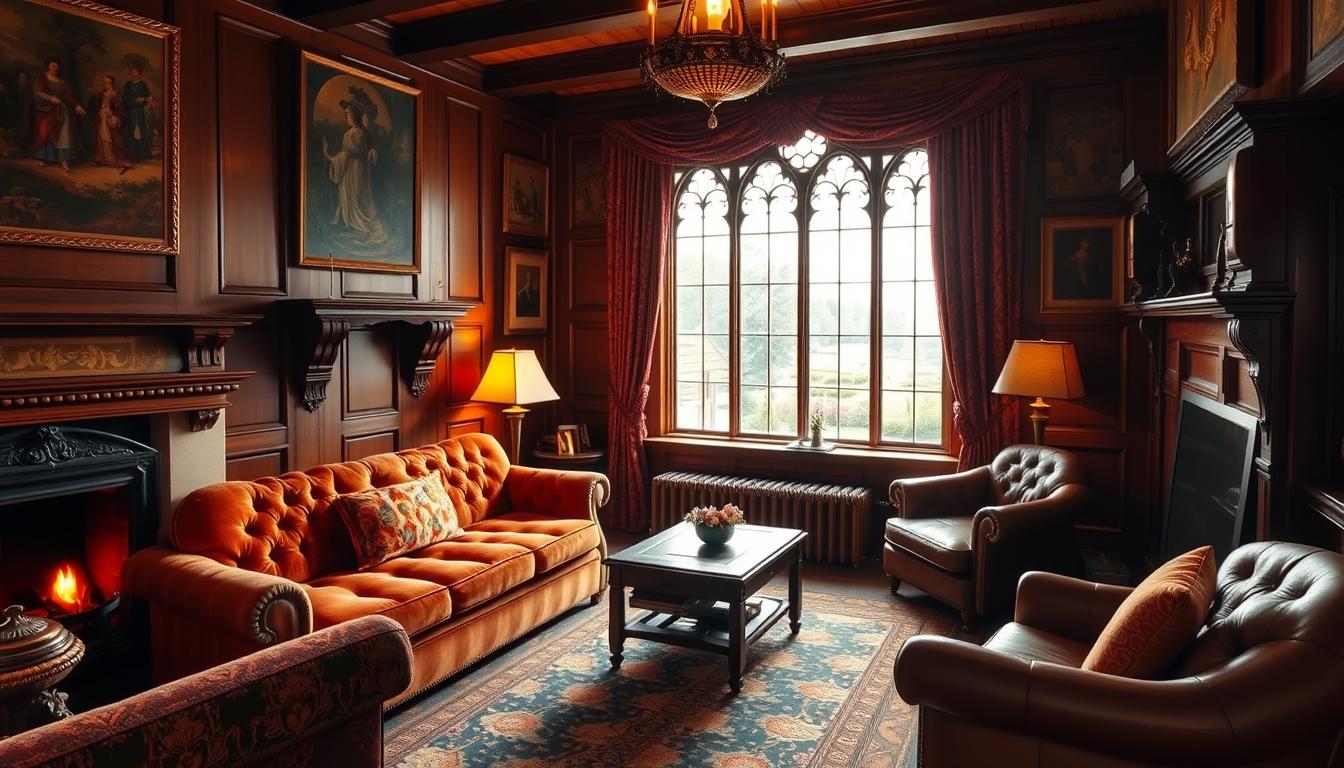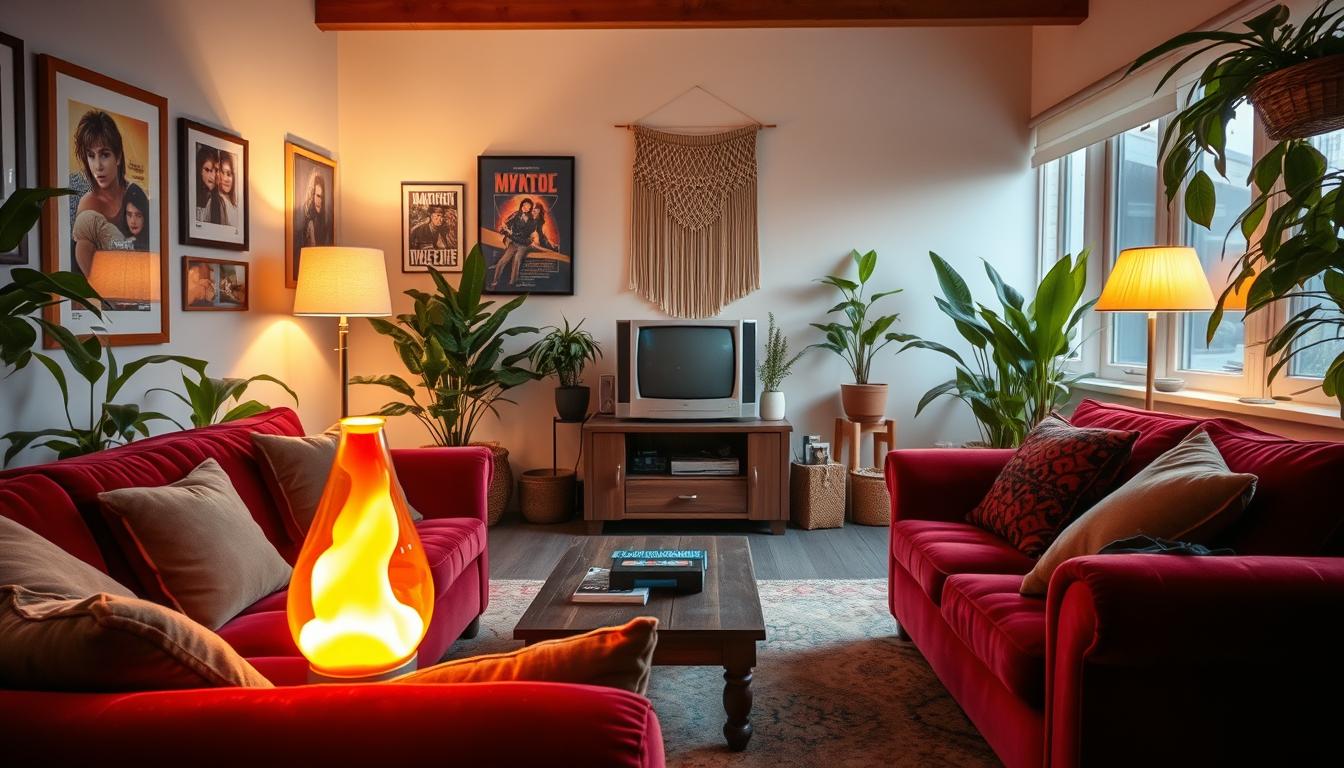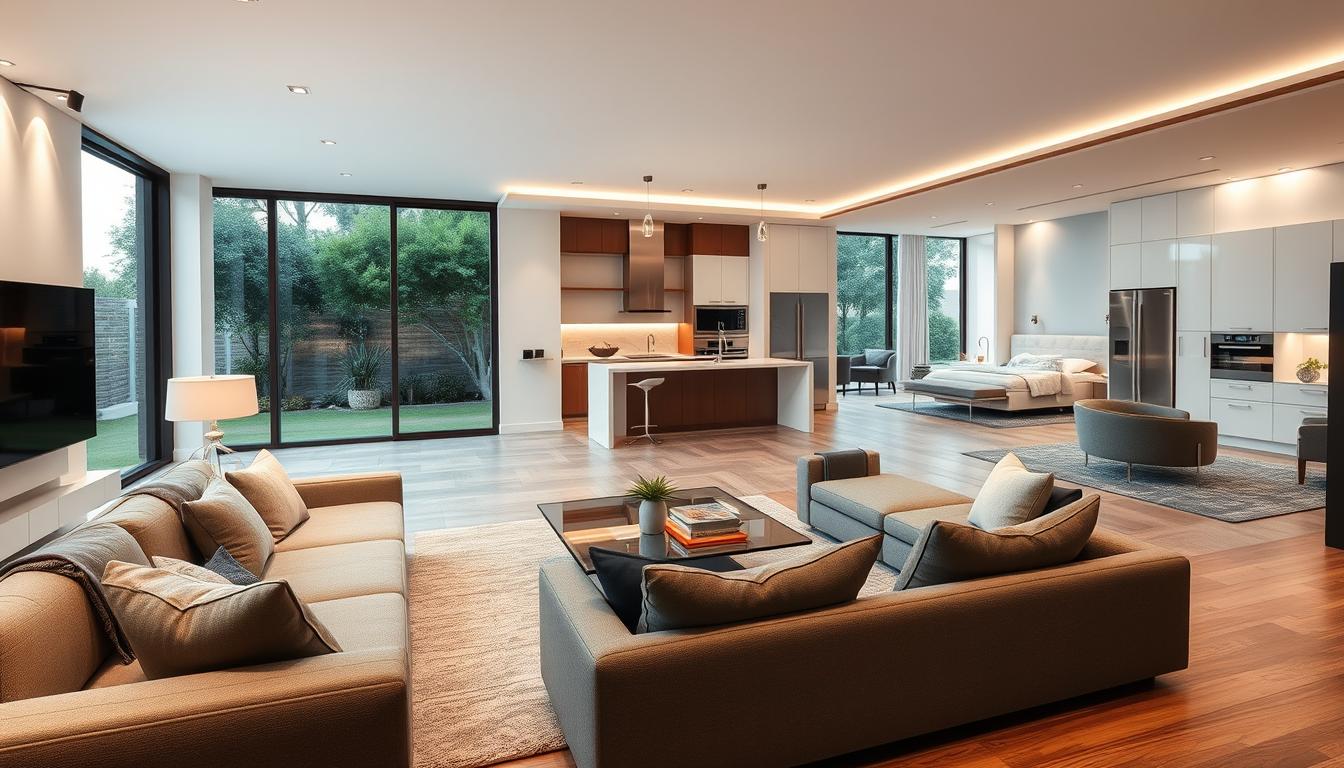Did you know that Tudor-style homes have been popular in America since the early 1900s? They are known for their steep roofs, tall chimneys, and detailed woodwork. These homes bring a sense of history and tradition to any place.
To capture the true spirit of these homes, we need a careful approach to interior design. In this guide, we’ll look at the essential elements for a stunning interior. We’ll see how to keep the Tudor heritage alive while adding modern comforts.
Key Takeaways
- Understand the historical context of Tudor architecture
- Learn how to incorporate traditional elements into modern design
- Discover the importance of materials and textures in creating an authentic look
- Explore how to balance heritage with modern comforts
- Get tips on selecting furniture and decor that complements the Tudor aesthetic
Understanding Tudor-Style Architecture
Tudor-style architecture is a unique blend of medieval and Renaissance elements. It has captivated homeowners for centuries. To design a Tudor-style home interior, knowing the architectural style is key.
We will explore Tudor homes’ key features, like their use of brick, stone, and timber framing. We’ll also look at the historical context of this style. By understanding Tudor architecture, we can appreciate its unique design elements.
Key Characteristics of Tudor Homes
Tudor homes have distinct features. These include:
- Use of brick, stone, and timber framing
- Steeply pitched roofs, often with multiple gables
- Ornate detailing, such as carved wood and decorative brickwork
- Multi-paned windows, often with leaded glass
| Feature | Description | Design Impact |
|---|---|---|
| Brick and Stone | Used for exterior walls, adding durability and texture | Creates a sense of solidity and tradition |
| Timber Framing | Exposed wooden beams and frames, often ornately carved | Adds warmth and character to interiors |
| Steeply Pitched Roofs | Roofs with multiple gables, contributing to the home’s complex silhouette | Enhances the home’s visual appeal and creates additional space |
Historical Context and Evolution
The Tudor style began in 16th-century England, during the Tudor monarchs’ reign. It was shaped by medieval and Renaissance styles. This reflects the cultural and social changes of the time.
Understanding Tudor homes’ history helps us value their design elements. This knowledge guides our design choices for Tudor-style interiors. It ensures they are authentic and respectful of the style’s heritage.
The Importance of Authenticity in Design
The heart of Tudor interior design is its authenticity. This is achieved by keeping its unique features intact. Authentic Tudor home decor is more than looks; it’s about respecting the style’s history and architecture.
To keep Tudor interiors true to form, it’s important to know its key elements. These include rich woodwork, detailed ornamentation, and colors from the era. Tudor interior colors often include earthy tones, rich reds, and deep greens. These colors reflect the period’s dyeing and painting methods.
Embracing Original Features
Keeping Tudor home design authentic means embracing its original features. Features like exposed beams, wooden paneling, and ornate fireplaces are key to the Tudor style. When renovating or designing a Tudor home, it’s vital to either keep these elements or replicate them accurately.
For example, exposed beams in a Tudor-style living room are stunning. They add strength and beauty, enhancing the space’s authenticity. Wooden paneling and detailed ornamentation on walls and ceilings also add to the Tudor ambiance.
Choosing Reputable Materials
The materials used are crucial for an authentic Tudor interior. Natural materials like oak, walnut, and stone create a true Tudor feel. These were common in Tudor homes and remain relevant today.
| Material | Characteristics | Use in Tudor Design |
|---|---|---|
| Oak Wood | Durable, rich texture | Paneling, flooring, beams |
| Stone | Natural, varied textures | Fireplaces, wall cladding |
| Walnut | Dark, luxurious finish | Furniture, woodwork |
Choosing materials typical of the Tudor era and using original features ensures an authentic Tudor interior. This approach respects the style’s history and creates a welcoming space.
Essential Elements of Tudor-Style Interiors
Tudor-style interiors mix old charm with today’s comforts. When you’re designing or updating a Tudor home, it’s key to include traditional touches. These elements are what make this style unique.
Exposed Beams and Woodwork
Exposed beams and detailed woodwork are key to Tudor interiors. They add strength and warmth, making a space feel special. We suggest staining or painting these features to make them stand out.
Stone Fireplaces as Focal Points
A stone fireplace is the heart of a Tudor home. It brings warmth and grandeur, making any room cozy. Choose natural stone for your fireplace to keep it true to the style.
Multi-Paned Windows
Multi-paned windows are vital in Tudor interiors. They let in lots of light while keeping the classic look. Opt for windows with grids or muntins for that authentic feel.
Adding these elements makes a Tudor-style interior welcoming and true to its roots. Whether you’re redoing a tudor home renovation or starting from scratch, these features will set the right mood.
Color Palettes for Tudor Interiors
To truly capture the spirit of a Tudor home, it’s essential to understand the color palettes that were characteristic of this architectural style during its heyday. The right colors can evoke the warmth and coziness associated with Tudor interiors.
Earthy Tones and Rich Colors
Tudor homes are renowned for their use of earthy tones and rich colors. These were largely influenced by the materials available during the Tudor period. These colors include:
- Warm wood tones, such as oak and walnut, which were used extensively in paneling and furniture.
- Deep, rich colors like crimson and burgundy, often used in fabrics and upholstery.
- Earthy shades of green and brown, which reflected the natural surroundings.
These colors were not only aesthetically pleasing but also reflected the social status of the homeowner. Richer colors indicated greater wealth.
Accent Colors That Compliment
Accent colors play a crucial role in enhancing the overall aesthetic of a Tudor-style interior. When choosing accent colors, consider hues that complement the earthy tones and rich colors characteristic of the Tudor style. Some options include:
| Accent Color | Complimentary Colors | Usage |
|---|---|---|
| Gold | Deep reds, rich browns | Used in decorative accessories, lighting fixtures. |
| Cream | Earthy greens, warm beiges | Often used in textiles, wall paint. |
| Soft Blues | Warm woods, muted greens | Can be used in upholstery, accent walls. |
By carefully selecting a color palette that honors the Tudor style, homeowners can create a warm and inviting atmosphere. This atmosphere pays homage to the home’s heritage.
Furniture Selection for Tudor Spaces
To make a Tudor-style living space, picking the right furniture is key. It should match the era’s craftsmanship and design. The right pieces not only look great but also honor the home’s history.
Traditional Furniture Styles
Tudor homes use solid, high-quality materials and detailed craftsmanship. Look for furniture made from oak and walnut. These woods are strong and have beautiful grain patterns that warm up a room.
Furniture with intricate carvings and ornate details is typical of Tudor style. Choose pieces with carvings of foliage, scrollwork, or other motifs. These reflect the period’s love for detailed craftsmanship.
Incorporating Modern Must-Haves
Keeping Tudor design traditional is important, but adding modern comforts is key. Comfortable seating is essential. Consider upholstering traditional Tudor-style chairs with modern fabrics for better comfort.
Blending modernity with tradition is possible. You can add advanced technology to your furniture. For example, smart TVs can be mounted or hidden in traditional cabinetry. Or, choose furniture with built-in USB ports and charging stations.
By mixing traditional styles with modern needs, you can have a Tudor-style home that’s both authentic and comfortable.
Textiles and Fabrics in Tudor Design
To get a true Tudor feel, picking the right textiles and fabrics is key. These elements help make Tudor interiors warm and full of character.
For a Tudor home, go for velvet, linen, and wool. These materials were big back then. They add realness and warmth to your rooms.
Choosing Period-Appropriate Textiles
It’s important to use textiles that fit the Tudor time. Look for damask, tapestry, and embroidered linen. These patterns were common then and make your decor feel more authentic.
Here’s a look at some Tudor-era fabrics:
| Fabric | Characteristics | Use in Tudor Decor |
|---|---|---|
| Velvet | Luxurious, soft, and richly textured | Used for upholstery and drapery to add opulence |
| Linen | Natural, breathable, and versatile | Commonly used for bedding, curtains, and tablecloths |
| Wool | Warm, durable, and often patterned | Used for rugs, upholstery, and wall hangings |
Layering Fabrics for Comfort
Layering fabrics makes your Tudor home cozy and interesting. Start with thick drapes or curtains in velvet or tapestry. Then, add throw blankets, rugs, and furniture in matching textures and patterns.
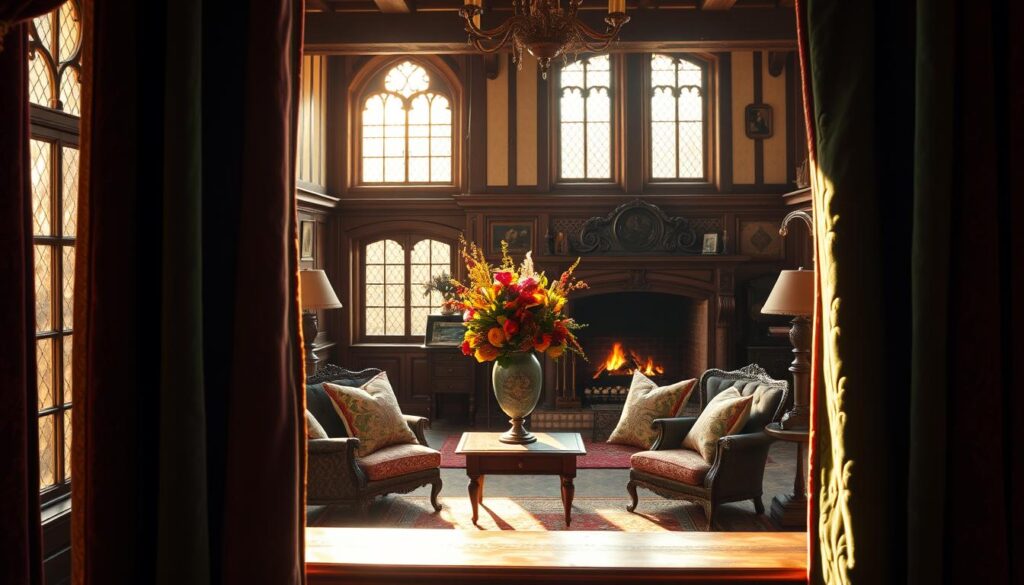
By choosing and layering the right fabrics, you’ll make your Tudor home cozy and inviting. This way, you honor Tudor design while keeping your home comfy and welcoming.
Create Warm and Inviting Spaces
To make your Tudor-style home feel real, focus on creating warm and inviting spaces. Think about lighting and decor carefully. These elements are key to your home’s feel.
Lighting Solutions for a Cozy Ambiance
Lighting is crucial for your Tudor home’s vibe. Use a mix of light sources for coziness. Table lamps with fancy bases or ceramic can warm up a room. Floor lamps add light and become room highlights.
Fireplaces are essential in Tudor homes, offering warmth and becoming room centers. Add candles or LED candles for a cozy glow. Dimmable lights also help change the mood, from cozy nights to big gatherings.
Accessorizing with Vintage Decor
Adding vintage decor brings character to your Tudor home. Look for items that match the era, like antique furniture and classic art. These pieces add history and authenticity.
Choose vintage decor that fits your style. Rich, earthy tones work well with Tudor interiors. Mixing old with new creates a space that’s both timeless and modern.
With the right lighting and vintage decor, your Tudor home will be warm and welcoming. It will feel both authentic and inviting.
Landscaping Considerations
To make your Tudor-style home look great, think about your landscaping. The outside of your home is as important as the inside. Good landscaping can really make your home look better.
Designing Outdoor Spaces to Match
When you design your outdoor areas, pick things that go well with Tudor style. Use brick, stone, and wood for paths, patios, and garden features.
Adding topiaries and formal gardens can make your outdoor space elegant. These were common in Tudor gardens. They help tie your home’s inside and outside together.
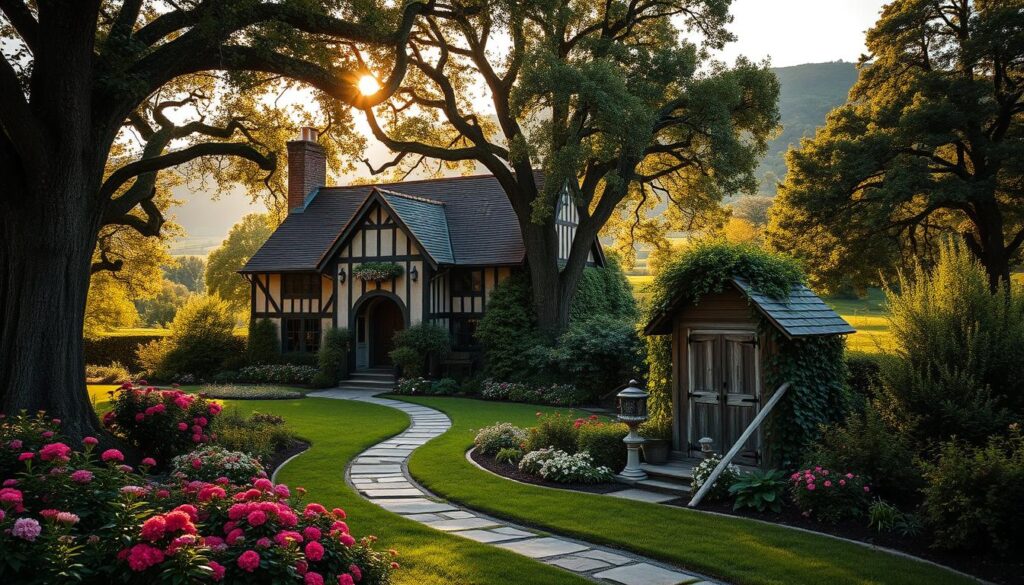
Tudor-Style Garden Features
Tudor gardens are known for their neat, symmetrical designs. You can make your garden look like this by using formal gardens with a central point, like a fountain or statue.
| Feature | Description | Benefits |
|---|---|---|
| Topiaries | Clipped shrubs shaped into decorative forms | Adds elegance and structure to the garden |
| Formal Gardens | Symmetrical garden designs with manicured plants | Creates a sense of order and tranquility |
| Stone Pathways | Pathways made from natural stone | Provides a durable and attractive walkway |
Adding Tudor-style garden features to your landscaping can make your outdoor space beautiful. It will match your home’s style perfectly.
Tips for Small Tudor-Style Interiors
Maximizing space in a small Tudor-style home means embracing its warmth and character. It’s about making the most of the style while keeping things functional. Tudor homes, with their traditional charm, can be tricky to design, but it’s doable in smaller spaces.
Maximizing Space While Maintaining Character
To keep a Tudor home’s character, focus on its key features like exposed beams and wooden paneling. Multi-functional furniture is crucial in small spaces. It should serve more than one purpose without losing its style.
- Use nested tables or storage ottomans to keep clutter at bay.
- Opt for wall-mounted shelves to save floor space.
- Select furniture with legs rather than bulky bases to create a sense of openness.
Smart Storage Solutions
Good storage is key in small Tudor homes to keep them clutter-free and charming. We suggest using custom-built storage that matches the home’s traditional look.
- Utilize the space under stairs for storage or a cozy reading nook.
- Install shelving units that are designed to fit snugly into corners or against walls.
- Consider antique or vintage storage pieces that add character to the space.
By using these tips, homeowners can have a beautiful, functional Tudor-style interior, even in small spaces. Our aim is to keep the essence of Tudor interior design alive while making the home more livable.
Bringing Modern Touches to Tudor Interiors
Mixing Tudor architecture with modern elements can make your home unique and welcoming. To do this, we need to pick modern pieces that go well with classic Tudor furniture.
Striking a Balance
Think about your Tudor home’s look when adding modern touches. We can add modern items like sleek lights or smart home systems. This keeps the Tudor style while making your home more modern.
Innovative Solutions for Historic Homes
Adding smart home tech can make your Tudor home more livable. We can mix old and new, creating a space that’s both beautiful and practical. It keeps the Tudor charm while adding modern convenience.

